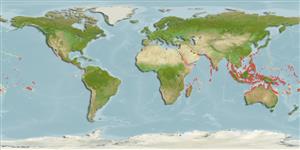Teleostei (teleosts) >
Gobiiformes (Gobies) >
Gobiidae (Gobies) > Gobiinae
Etymology: Istigobius: Greek, istios = sail + Latin, gobius = gudgeon (Ref. 45335).
More on author: Rüppell.
Environment: milieu / climate zone / depth range / distribution range
Ecology
Marine; brackish; reef-associated; depth range 0 - 5 m (Ref. 86942). Tropical; 21°C - 29°C (Ref. 27115); 30°N - 25°S
Indo-Pacific: Red Sea south to northern Mozambique (Ref. 4343) and east to Fiji, north to southern Taiwan, south to New Caledonia. Recently recorded from Tonga (Ref. 53797).
Size / Weight / Age
Maturity: Lm ? range ? - ? cm
Max length : 11.0 cm TL male/unsexed; (Ref. 9710)
Dorsal spines (total): 7; Dorsal soft rays (total): 10 - 12; Anal spines: 1; Anal soft rays: 9 - 11; Vertebrae: 26. Upper 3-4 pectoral fin rays free. Body color pale gray; operculum with 5 small blue spots interspersed with brownish red spots; 5 vertical rows of white spots on pectoral fins; anterior tip of first dorsal fin bright yellow. 4th spine of 1st dorsal fin longest. Predorsal scales cycloid, trunk ctenoid. Mouth with overhanging snout, lips greatly thickened. Cheeks and operculae without scales. Female pelvic and anal fins not as darkly pigmented as in male. Also with terete body shape, slightly depressed; eyes situated dorso-laterally; reduced swim bladders (Ref. 92840).
A common species that inhabits mangroves and silty, rocky areas; occasionally found in rubble reef areas. Only single individuals were observed; many individuals found scattered over a small area (Ref. 420). Found primarily in lower estuaries, usually in mangroves. This is the species of the genus that is found farthest inland. Feeds on small invertebrates (Ref. 12693).
Life cycle and mating behavior
Maturity | Reproduction | Spawning | Eggs | Fecundity | Larvae
Genital papilla, of male varying from lightly to heavily pigmented and terminating to side of anal spine. Female genital papilla lightly pigmented and truncate, terminating well before anal spine (Ref. 420). Benthic spawner (Ref. 32023).
Murdy, E.O. and D.F. Hoese, 1985. Revision of the gobiid fish genus Istigobius. Indo-Pac. Fish. (4):41 p. (Ref. 420)
IUCN Red List Status (Ref. 130435: Version 2024-2)
Threat to humans
Harmless
Human uses
Fisheries: commercial; aquarium: commercial
Tools
Fatal error: Uncaught mysqli_sql_exception: Too many connections in /var/www/html/includes/speciessummary.lib.php:2004
Stack trace:
#0 /var/www/html/includes/speciessummary.lib.php(2004): mysqli->__construct()
#1 /var/www/html/summary/speciessummary.php(1812): checkRecordDisplayFBQuizV2()
#2 {main}
thrown in /var/www/html/includes/speciessummary.lib.php on line 2004
